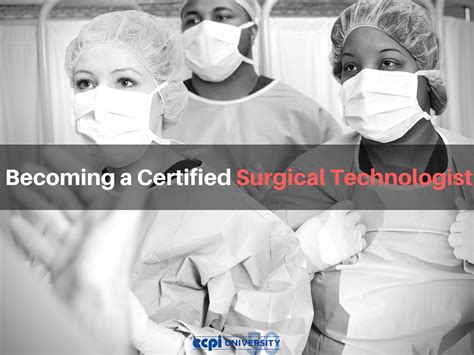Becoming a surgical technologist, also known as a surgical tech or operating room technician, can be a rewarding and challenging career in the healthcare industry. One way to achieve this goal is by enrolling in a Surgical Technologist (ST) program offered by a community college or vocational school. In this article, we will outline the 5 steps to become a surgical tech via an ST program.
Step 1: Meet the Basic Requirements

Before applying to an ST program, it is essential to meet the basic requirements. These requirements may vary depending on the program, but typically include:
- Earn a high school diploma or equivalent
- Complete prerequisite courses in sciences, such as anatomy, biology, and chemistry
- Take the Health Education Systems, Inc. (HESI) Admissions Assessment (A2) exam or the Test of Essential Academic Skills (TEAS)
- Maintain a minimum GPA, usually 2.5 or higher
Prerequisite Courses
Some ST programs may require students to complete specific prerequisite courses, such as:
- Anatomy and physiology
- Biology
- Chemistry
- Math
- English
These courses help prepare students for the rigors of the ST program and provide a foundation in sciences.
Step 2: Choose an Accredited ST Program

When selecting an ST program, it is crucial to choose one that is accredited by the Commission on Accreditation of Allied Health Education Programs (CAAHEP) or the Accrediting Bureau of Health Education Schools (ABHES). Accreditation ensures that the program meets the standards and quality of education required by the profession.
Types of ST Programs
There are different types of ST programs available, including:
- Certificate programs
- Diploma programs
- Associate's degree programs
- Bachelor's degree programs
Certificate and diploma programs typically take a year or less to complete, while associate's and bachelor's degree programs take two and four years, respectively.
Step 3: Complete the ST Program

Once enrolled in an ST program, students will complete a combination of classroom and clinical training. The program will cover topics such as:
- Surgical technology
- Anatomy and physiology
- Pharmacology
- Patient care
- Medical terminology
- Surgical procedures
Students will also participate in clinical rotations, which provide hands-on experience in the operating room.
Clinical Rotations
Clinical rotations are a critical component of ST programs. During these rotations, students will work under the supervision of experienced surgical technologists and gain practical experience in the operating room.
Step 4: Pass the Certification Exam

After completing the ST program, graduates are eligible to take the certification exam offered by the National Board of Surgical Technology and Surgical Assisting (NBSTSA). The exam is designed to assess the knowledge and skills of surgical technologists.
Certification Benefits
Certification as a surgical technologist has several benefits, including:
- Increased job prospects
- Higher salary potential
- Professional recognition
- Opportunities for advancement
Step 5: Maintain Certification and Pursue Continuing Education

To maintain certification, surgical technologists must complete continuing education requirements and adhere to the NBSTSA's certification renewal policy.
Continuing Education Requirements
The NBSTSA requires certified surgical technologists to complete 60 hours of continuing education every four years. This ensures that certified technologists stay current with the latest techniques, technologies, and procedures in the field.






What is the average salary for a surgical technologist?
+The average salary for a surgical technologist varies depending on location, experience, and employer. However, according to the Bureau of Labor Statistics, the median annual salary for surgical technologists was $48,330 in May 2020.
What are the job prospects for surgical technologists?
+The job prospects for surgical technologists are excellent. The Bureau of Labor Statistics predicts that employment of surgical technologists will grow 7% from 2020 to 2030, faster than the average for all occupations.
What is the difference between a surgical technologist and a surgical assistant?
+A surgical technologist and a surgical assistant are both members of the surgical team, but they have different roles and responsibilities. A surgical technologist is responsible for preparing the operating room, sterilizing equipment, and assisting the surgeon during procedures. A surgical assistant, on the other hand, is a medical professional who assists the surgeon during procedures and may also be responsible for closing incisions and applying dressings.
In conclusion, becoming a surgical technologist via an ST program requires dedication, hard work, and a passion for the healthcare industry. By following the 5 steps outlined in this article, aspiring surgical technologists can set themselves up for success and embark on a rewarding career in this field.
